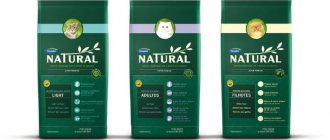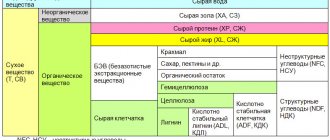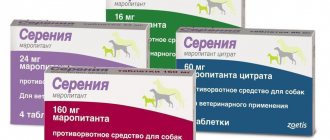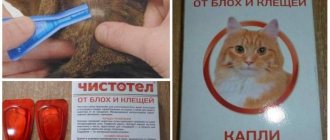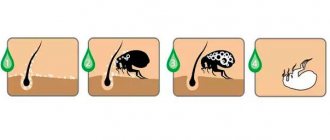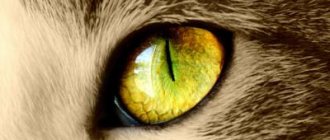Where does ash come from?
Of course, no one deliberately adds ash to dry food. This word refers to all the minerals contained in the feed product. The roots of such a strange name lie in the method of determining the level of content of these substances: a portion of the feed is burned in a special oven, and then the dry residue, which is externally ash and ash, is evaluated.
From a chemical point of view, these are magnesium, calcium, phosphorus and other minerals. They go into feed together with raw materials: meat, fish, poultry and other products.
Carbohydrates
Potatoes are used with the peel, which contains all the useful substances. Potatoes contain carbohydrates, zinc, copper, iron, potassium, magnesium, vitamins B and C, and niacin.
Sweet Potatoes Potatoes contain carbohydrates, zinc, copper, iron, potassium, magnesium, vitamins B and C, and niacin. Sweet potatoes are also rich in beta-carotene, etc. They do not cause allergies.
Flaxseed meal A source of Omega-3 and Omega-6 fatty acids. Thanks to this component, the wool looks soft and shiny. An anti-constipation remedy with anti-carcinogenic properties. The best plant source of alpha-linoleic acid.
Barley Whole grain barley is a very good and high-quality source of carbohydrates.
Crushed barley Crushed grain is not a particularly valuable component, since during the processing all useful substances were removed from it.
Hercules Dry product from purified oat grains. An excellent source of carbohydrates, rich in vitamin B. Sometimes used as a binder for dry food, which avoids artificial fixatives.
Oat gluten Gluten from oat processing products. Poorly absorbed by the body.
Rice Whole, refined grains of rice without bran, called white rice, are a high-quality source of carbohydrates, protein and gluten. In addition, it is a natural remedy for consolidating stool and lowering cholesterol levels. The least allergenic grain product.
Rice Flour Rice flour, like broken rice, is much less valuable than whole grains.
Beer rice Dry extracted grain residue formed after the production of wort (the liquid part of malted grain) or beer and may contain dusty dry spent hop cones in an amount not exceeding 3%. Cheaper and less valuable product compared to whole rice.
Millet is quite a nutritious filler. But biologically less suitable for animal nutrition than other grain crops.
Sorghum is a nutritious product that is extremely difficult for animals to digest. Can lead to severe digestive disorders!
Corn is potentially dangerous because... widely used in feed as a cheap source of protein, not always of high quality.
Corn gluten/corn flour - potentially allergic! Grain vegetable protein. The shelled part of the grain that remains after most of the starch and protein have been extracted in the process of producing starch or molasses. Cheap filler. It is an allergen for many animals.
Cellulose powder is potentially dangerous. Usually made from corn milling. Used as a filler and binder to reduce the cost of feed.
Wheat/Wheat flour - potentially allergic. A good source of carbohydrates, nutritious filler, rich in vitamins and minerals. Unfortunately, it causes an allergic reaction in many dogs.
Wheat gluten is potentially allergenic. A cheap by-product formed during grain processing. It has virtually no nutritional value and serves mainly as a binder.
Beet pulp An extract isolated during the processing of beets for the production of sugar, as well as its dried version. Natural stool fixative.
Dried beet pulp Dry extract obtained from the processing of sugar beets. Natural stool fixative.
Vegetable Blend A source of plant fiber from a mixture of various plants and vegetables.
Is ash harmful to cats?
Increased interest in this indicator arose when the mechanism of stone formation in the urinary tract of cats became clear. It turned out that the crystals that settle in the urine consist of certain minerals. From this it was hastily concluded that the presence of these substances in feed is undesirable and should be reduced as much as possible.
Meat products are the leaders in terms of mineral content. But plant foods contain significantly less of these substances (this is explained by the peculiarities of plant metabolism). Therefore, the discovery of the mechanism of formation of urinary stones has become an indulgence for manufacturers wishing to produce feed from cereals and other plant components. However, a grain diet did not rid cats of ICD, because in practice everything turned out to be more complicated.
Which raw material contains more ash?
Ash is contained in all products, but as for meat, there is much less ash in muscle tissue than in bones. Carefully read the composition of food with high ash, preferably in English, and you will see that mainly whole carcasses (with bones) will be used as meat ingredients in such food, rather than fillets. But feed with a high content of cereals will have a very low ash content. So the more meat (even with bones), the better the food, and the inevitably higher the ash.
Calcium and phosphorus - under control
Subsequently, it was discovered that not all minerals are responsible for the formation of stones. The main materials for this “construction” turned out to be calcium and phosphorus, and not separately, but together and in a certain proportion. Unlike ash, the calcium and phosphorus content is required to be indicated on packages of finished feed. It is these values, and not the ash content, that you should rely on when choosing a diet.
The recommended calcium to phosphorus ratio is 1.2:1. But options ranging from 1.17:1 to 1.4:1 are acceptable. These figures were obtained by analyzing the content of these minerals in the carcasses of rodents, which are the typical food of cats in their natural habitat.
Information about the calcium-phosphorus ratio is not always indicated. But nothing prevents you from calculating this parameter yourself: you just need to divide the calcium indicator by the phosphorus indicator. Ideally, the resulting number will be close to 1.2.
But even this will not provide complete protection against urolithiasis if another risk factor is not taken into account, which is associated not only with ash content - the acidity of urine.
What is ash content
Sometimes cat owners wonder why ash is needed in food. When a little purr eats natural food, no one feeds it with ash. The fact is that the indication “ash” on the packaging is the amount of non-combustible residue formed when 100 g of feed is burned at a temperature of 500 °C. You should pay attention to this indicator when choosing diets for your cat.
The feed contains organic (fats, proteins and carbohydrates) and inorganic (minerals) substances. Organic substances burn completely, and when inorganic components are burned, a non-combustible residue remains. The percentage is called ash content. In other words, this is an indicator of the content of minerals in the diet.
Acidic versus alkaline
Normally, all carnivores, including cats, have slightly acidic urine (pH up to 6.5). This is what becomes a kind of “immunity” from the formation of stones. Indeed, in an acidic environment, crystals, which then turn into stones, are not able to form, and as a result, their potential components leave the body along with urine.
If the urine becomes alkaline and the pH reaches 7, then the risk of crystal formation increases sharply. And here the high content of minerals in food can play a negative role.
What causes alkalinization of urine? Magnesium is often blamed for this - it is always contained in ash in dry food. It can really affect the pH and tip the scales towards the alkaline side.
Some misconceptions
Sometimes people who are especially careful about their diet pay attention to the pH (acidity) of food ash. In different products, depending on their mineral composition, the ash remaining after metabolism can be acidic, neutral or alkaline. In animal products and grains it is acidic, in vegetables and fruits it is alkaline. It is believed that products containing alkaline ash change the pH of the blood and destroy harmful cells, including those that cause cancer. Meanwhile, not all experts share this opinion. Many still insist that food can only change the pH of urine, but not the blood, and if such a process actually occurred, it would have a very dangerous effect on the organs.
Optimal Magnesium Levels
It is impossible to significantly reduce the level of magnesium in an animal’s diet, since it is an important trace element involved in more than 300 metabolic processes in the body. Scientists and industry specialists had to take this issue seriously and conduct a series of experiments.
As a result, it was possible to reveal that the optimal level of magnesium in dry food is approximately 1000 mg/kg (0.1%). However, do not be afraid of a higher value, because the need for magnesium depends on parameters such as age and other characteristics of the animal’s body. In some diets this figure may be significantly higher, and this is normal. The maximum limit, after which the risk of urolithiasis increases sharply, is 3500 mg/kg (0.35%). However, you will not find such values in any ready-made diet.
Protein in dog and cat food - pros and cons
Protein in dog and cat food - pros and cons.
You can read the entire article in full or go to the section you are interested in by clicking on its title in the table of contents.
1. PROTEIN QUALITY.
- GENERAL INFORMATION ABOUT PROTEINS.
- NOT ALL PROTEINS ARE THE SAME.
- BIOLOGICAL VALUE OF PROTEINS.
- WHY CAN YOU NEVER COMPARE DOG FOOD BASED ON THE SPECIFIED PROTEIN PERCENTAGE?
- TEMPERATURE AND QUALITY OF PROTEINS.
- ASH CONTENT AND PROTEIN QUALITY.
2. THE NUMBER OF PROTEINS – DISBUSTING MYTHS.
- MYTH No. 1. PROTEINS AFFECT THE KIDNEYS.
- MYTH No. 2. PROTEINS CAUSE PUPPIES TO GROW TOO RAPIDLY.
- MYTH No. 3. FOR AGING DOGS, PROTEIN CONTENT SHOULD BE LIMITED.
- MYTH No. 4. PROTEIN IS HARMFUL FOR THE HEALTH OF OVERWEIGHT DOGS.
- WHERE DO SO MANY MYTHS COME FROM?
1. PROTEIN QUALITY.
GENERAL INFORMATION ABOUT PROTEINS.
Protein is the building block of all living things. Every living organism (from a huge mammal to the smallest microbe) consists of proteins. In various forms, proteins take part in the most important chemical processes that support the vital functions of the body.
- The body of dogs and cats needs proteins for basic cellular functions and for the life of the body as a whole, including the regeneration and restoration of cells, ensuring the vital activity and regulation of tissues, the production of hormones and enzymes, as well as maintaining water balance and providing the body with energy.
- If an insufficient amount of protein is supplied with food, the body begins to use its own tissue proteins. Since the body cannot store amino acids, it will break down its own protein structure, including healthy muscle, to obtain the amino acids it needs.
- It is necessary to ensure that the body receives a wide range of amino acids, the sources of which are fish, poultry and eggs.
- Protein is important for dogs at any age, and its quality is equally important.
- Protein requirements cannot be met by feeding grains, starches and vegetables. Feeds rich in carbohydrates may be deficient in protein.
- Despite the fact that plants are a source of fiber and some vitamins and minerals, only animal proteins can provide the body with a complete and balanced set of amino acids necessary for health and longevity.
NOT ALL PROTEINS ARE THE SAME.
Proteins differ greatly from each other depending on their:
a) SOURCE (animals or plants)
b) SET OF AMINO ACIDS
c) ABILITY
Good quality proteins are almost always of animal origin because they are quickly digestible and contain essential amino acids in amounts that meet the needs of dogs and cats.
a) SOURCE OF PROTEIN: ANIMALS OR PLANTS?
ANIMAL PROTEINS obtained from eggs, meat and fish are considered high quality or “complete” because they contain sufficient amounts of amino acids.
- Animal tissues are easier to digest and absorb in the body.
- Animal proteins contain all the essential amino acids for dogs and cats.
- Meat, poultry and fish are rich sources of proteins of high biological value.
- The criteria for assessing protein quality are based on the nutritional value of a chicken egg. It is believed that this product contains all essential amino acids in sufficient quantities.
PLANT PROTEINS derived from cereals, corn and vegetables are considered “incomplete” because they lack essential amino acids and do not maintain the overall balance of amino acids.
- Plant-based proteins usually lack essential amino acids such as arginine, taurine, methionine, lysine and tryptophan. Corn, for example, does not contain lysine, tryptophan and glycine. A deficiency of these essential amino acids reduces the quality of dietary protein.
- Corn has a total protein content of about 9%. However, essential amino acids account for no more than half (4.5%) of this amount. In other words, to create the required percentage of protein in a product, more plant proteins are required than animal proteins, but even in this case, there will be a lack of important amino acids.
b) AMINO ACIDS.
Proteins are made up of chains of linked chemicals called building blocks known as amino acids. In total, dogs require 22 different amino acids. 12 of them can be produced in the body of dogs (in the liver). The remaining 10 are not able to be produced in the body, so they must be supplied with food. These amino acids are called "essential".
ESSENTIAL AMINO ACIDS – These amino acids can be produced in the body. That is why their presence in the diet is not mandatory.
ESSENTIAL AMINO ACIDS – These amino acids cannot be produced by the body and therefore must be supplied in the diet.
Below are the 10 essential amino acids needed to meet the nutritional needs of dogs and a brief description of their functions.
- ARGININE: Stimulates the immune system and produces growth hormones (growth hormones), and supports the liver through ammonia detoxification.
- HISTIDINE: Histamine production, closely associated with pain relief, dilates small blood vessels to stimulate stomach acid production.
- ISOLEUCINE and LEUCINE (see VALINE LYSINE): promoting bone growth in puppies and stimulating the secretion of gastric juices.
- METHIONINE: Promotes gallbladder function, helps prevent fatty liver deposits, balances urinary tract pH, and increases taurine levels.
- PHENYALANINE: effects on appetite regulation, increased blood pressure during hypotension, work with minerals responsible for skin and hair pigmentation, production of adrenaline and norepinephrine.
- THREONINE: control of energy use, effects in conditions of elation or depression, production of adrenaline and preconditioning of thyroid hormones (thyroid gland).
- TRYPTOPHAN: production of serotonin, which induces sleep.
- VALINE, (ISOLLEUCINE AND LEUCINE): These essential amino acids work together to regulate protein and energy metabolism.
- TAURINE: is involved in many metabolic processes and can be converted into an essential amino acid under certain circumstances. Taurine affects the visual pathways, the brain and nervous system, cardiac function, and is also a bile acid conjugator.
The overall quality of food proteins consists of such parameters as the presence, balance and quality of essential amino acids.
c) PROTEIN DIGESTABILITY.
Protein digestibility is a key criterion for its quality. After all, what's the point of eating higher quality protein if it's not fully digestible? Animal protein is the best choice; it is easily absorbed by the body and contains all the amino acids necessary for dogs and cats.
To better understand the digestibility of proteins, it is necessary to remember that it actually represents the gradual breakdown of feed into components small enough to be absorbed through the intestinal walls into the blood.
- High protein digestibility can be characterized by a food that is easier and faster than others to break down into easily absorbable components.
- Protein components that meet the amino acid needs of animals and are highly digestible are almost always of animal origin.
- In the short digestive tract of dogs and cats, plant proteins are absorbed much worse than animal proteins.
- High levels of trypsin inhibitors in pulses can lead to a significant reduction in protein and amino acid digestibility (up to 50%) in rats and pigs. Similarly, high levels of tannins in grains (e.g. sorghum) and pulses can cause significant reductions in protein and amino acid digestibility (up to 23%) in rats, poultry and pigs1.
BIOLOGICAL VALUE OF PROTEINS (BC).
Some protein sources are better than others because they provide a more complete set of amino acids. The better the proteins, the higher their so-called “biological value” (BC). Biological value is a measurement scale used to determine the percentage of the body's absorption of a given nutrient source. Simply put, BC indicates how well the body can actually use protein. Theoretically, the maximum BC of any power source is 100%.
Table 1. ASSESSMENT OF PROTEINS BY THEIR BIOLOGICAL VALUE.
| PRODUCT | PROTEIN ASSESSMENT |
| Eggs (whole) | 100 |
| Eggs (whites) | 88 |
| Chicken/Turkey | 79 |
| Fish | 70 |
| Lean beef | 69 |
| Brown rice | 59 |
| Brown rice | 57 |
| White rice | 56 |
| Peas | 55 |
| Wheat | 49 |
| Soybeans | 47 |
| Whole grain wheat | 44 |
| Corn | 36 |
| Ripe beans | 34 |
WHY CAN YOU NEVER COMPARE DOG FOOD BASED ON THE SPECIFIED PROTEIN PERCENTAGE? 2
Do you think it's hard to fool you? Better think again.
When you go to the store to buy dog food, you can't trust the protein percentage listed on the label. No, actually you can't, and here's why. Let's say you have a pair of old leather boots, some used motor oil, and a scoop of sawdust. Now grind them, mix thoroughly and send the resulting mixture to the feed testing laboratory for analysis.
What will be the results? This poisonous mixture of garbage contains:
Belkov – 32%
Fat – 18%
Fiber – 3%
The numbers suggest that this fancy concoction looks quite attractive, but in reality it is as attractive as any quality dog food.
The skin provides proteins. Motor oil is fats. And sawdust provides the appropriate amount of fiber. However, you would never feed this to your dog. Do you see how easy it is to be deceived?
TEMPERATURE AND PROTEIN QUALITY.
High temperature and prolonged exposure alter amino acid compounds and therefore reduce protein quality. In addition, cooking foods at high temperatures destroys amino acids such as methionine and histidine.
High temperatures create bonds between proteins and carbohydrates, which interferes with the digestibility of proteins.
A number of experiments were conducted to evaluate the quality of protein in different types of flour - from fresh meat (without pre-processing) and from pre-processed by-products, which are commonly used in pet food.
The BC of raw beef tested on rats was found to be higher than the biological value of the same meat processed in three different ways. The BC of raw beef is 67. For beef processed by boiling at normal pressure - 60, boiling for 7 minutes - 62, and boiling for an hour at 15 pounds of pressure - 56. This causes thermal burn (due to increased protein), severity which depends on the duration of exposure to the temperature reached 3.
Another study compared raw and processed meat ingredients. To determine the biological value of protein efficiency ratio (PER) and net protein efficiency ratio (NPE), six (freeze-dried) types of raw ingredient flours (beef, pork, lamb, pork liver, ocean fish, chicken necks) and three types of flours from raw ingredients were studied. pre-processed meat ingredients (lamb meal, normal ash poultry waste meal and low ash poultry waste meal).
- The bioavailability of lysine for flours from raw animal ingredients ranges from 86% to 107%, and for flours from preprocessed ingredients from 70% to 99%.
- Bioavailability of amino acids ranges from 64% to 99% and from 61% to 78% for flours from raw and preprocessed animal ingredients, respectively.
- EBC values range from 2.83 to 4.03 for flours from raw ingredients and from 2.01 to 3.34 for flours from preprocessed animal ingredients. CNEB values range from 3.83 to 4.8 and 3.05 to 4.12 for raw and preprocessed animal flours, respectively.
- Despite the increase in the values of CEB relative to CEB, the overall ranking of meat meal types remains the same. The lowest values of CEB and CEB were noted for mutton (lamb) flour, and the highest - for pork.
- The total digestibility of essential amino acids and the total digestibility of all amino acids range from 93.6% to 96.7% and from 90.3% to 95.5%, respectively, for raw meat meal. And also - from 84.0% to 87.7% and from 79.2% to 84.8%, respectively, for flour from pre-processed meat ingredients.
- Flour made from pre-processed animal ingredients has lower protein quality than flour made from raw meat. The lowest quality of proteins is always in mutton (lamb) flour, and the highest is in pork liver 4.
ASH CONTENT AND PROTEIN QUALITY.
The impact of ash concentration on the composition of amino acids (AA), the actual digestibility of AA and the protein efficiency factor (PER; weight gain per unit of protein consumed) of meat and bone meal (MBM) was assessed.
Pre-processed MCM samples containing 16% to 44% ash were obtained from two sources. The protein quality of the selected MCM samples was assessed by determining the actual digestibility by assessing the cecectomized males after feeding the exact amount of feed, and by assessing the BEF of chick growth when fed a diet containing 10% crude protein (CP) containing also MCM as the sole source of dietary protein at the stage from the 8th to the 18th day of life.
- In all MCM samples, as ash content increased, there was an increase in ALA, PRO, GLY and ARG as a percentage of SB, taking into account Pro and Gly for maximum increase. In contrast, levels (% crude protein) of all essential amino acids other than Arg decreased as ash levels increased.
- For example, the Lys concentration per unit of SB decreased from 5.7% to 4.0% while the ash content increased from 9% to 63%.
- The effect of ash content on the digestibility of AA in meat and bone meal (when the ash content changed from 9% to 44%) turned out to be insignificant or absent altogether. As ash content increased from 16% to 44%, the BEF of meat and bone meal decreased markedly from 3.34 to 0.72, and the greatest effect of ash content on BEF was not due to the difference between calcium and phosphorus levels.
The results suggest that the decrease in protein quality of meat and bone meal as ash content increases is almost entirely due to a decrease in the analyzed essential amino acids per unit of crude protein, and not due to a decrease in amino acid digestibility5.
2. THE NUMBER OF PROTEINS – DISBUSTING MYTHS.
There are many incredible theories regarding the ideal amount of protein in the diet for dogs and cats.
Just ten years ago, it was believed that too much protein could cause health problems. This myth has been completely debunked by the scientific community. Contrary to popular belief, a high protein diet is beneficial for the health of dogs of all ages, including puppies of all breeds and sizes, aging dogs, and overweight dogs. Studies have shown that protein does not cause orthopedic problems in puppies or kidney disease in aging dogs. In fact, proteins are extremely beneficial: they support the immune and central nervous systems, promote wound healing, build muscle mass, and are also essential for healthy skin and coat.
Protein is essential for dogs and cats, and the more the better. There is absolutely no reason to limit the amount of protein your dog consumes.
Let's look at some of the most common myths about squirrels.
MYTH No. 1. PROTEINS AFFECT THE KIDNEYS.
There is no link between high protein diets and kidney disease in dogs.
For many years, there have been some erroneous assumptions in the literature about the need to reduce protein intake due to the risk of kidney disease. These are hypotheses such as:
- Increased urea levels lead to increased workload on the kidneys.
- High levels of dietary protein intake damage the kidneys.
- High dietary protein intake causes increased potassium levels in the blood (hyperkalemia).
- High levels of dietary protein consumption cause acidosis (disorders of the acid-base state in the body).
- Protein intake affects the level of uremic toxins.
- Reducing the level of protein consumed inhibits the development of kidney disease 6.
Research into dietary proteins and kidneys has shown that proteins do not cause kidney failure and are not associated with exacerbation or development of chronic kidney failure.
- The potential for excess dietary protein to cause renal disease has been studied in both dogs with chronic renal failure and in aging dogs without chronic renal failure. Numerous studies have confirmed that proteins do not have adverse effects on the kidneys 7.
- The same study found that lower levels of dietary protein may actually cause adverse effects on the kidneys.
A study was conducted at Pennsylvania State University to determine whether large amounts of dietary protein actually cause kidney damage in dogs. The dogs were given food with different protein contents: 19%, 27% and 56% for four years (that’s how long the study lasted). The results of the study confirmed that high levels of dietary protein do not have a negative effect on kidney function in dogs 8.
From the veterinary service of Drs. Foster & Smith, Inc.:
“High protein pet foods do NOT harm the kidneys of intact (non-experimentally exposed) animals.
During the digestion and conversion of proteins in animals, nitrogen is produced as a by-product. Excess nitrogen is excreted from the body by the kidneys. If there is a large amount of protein in the diet, more nitrogen is produced, and the kidneys simply excrete it into the urine. You, of course, have the right to assume that such a diet can “overload” the kidneys and lead to possible damage, but this is not so. The filtration capabilities of the kidneys are so great that even one of them is enough to maintain the normal functioning of the body. Many pets, like people, live full lives with just one kidney.”
As long as your veterinarian has not told you that your pet has kidney problems and needs to carefully regulate their protein intake, you can eat a high-protein diet without worrying about “damage” or stress on your pet's kidneys. Additionally, you will not protect your pet's kidneys by eating a low protein diet.
Moreover, a documented study in dogs found that reducing protein levels in the diet of aging dogs is unwise: “...restricting protein intake has no effect on the development of renal disorders or the preservation of renal function.” (See KIRKS VETERINARY THERAPY XIII, Small Animal Practice by WB Saunders, p. 861.)
MYTH No. 2. PROTEINS CAUSE PUPPIES TO GROW TOO RAPIDLY.
There is no direct link between high protein intake and musculoskeletal development in puppies and growing dogs of any size or breed.
Orthopedic problems in growing dogs are directly related to caloric intake, not protein.
Overfeeding causes puppies to grow too quickly, causing most of the skeletal and joint problems common among large breeds.
The key to healthy musculoskeletal development is keeping large breed puppies lean. A balanced diet high in protein has not been shown to have a negative impact on musculoskeletal development in carnivores. Excess energy intake, even as part of a balanced diet, increases both the incidence and severity of osteoarthritis (OA), which in turn affects the severity of lameness. Weight loss is both a precaution and part of an OA program 9. According to the same study, excess protein or fat intake has essentially no expected effects on musculoskeletal development, does not cause obesity, and is part of a balanced diet that meets the needs of animals in nutrients.
Consumption of excess energy causes excessive weight gain, which has a negative impact on the formation of hip joints in dogs prone to dysplasia.
A study was conducted at the Faculty of Veterinary Medicine at the University of Utrecht in the Netherlands to determine the role of dietary proteins, particularly in calcium metabolism and musculoskeletal development, in large breed dogs. 17 Great Dane puppies, seven weeks old, were divided into three groups. For 18 weeks, each group received dry food containing 32%, 23% or 15% protein on a dry matter basis. The researchers did not find any difference in height at the withers among representatives of the high protein (H-Pr), normal protein (N-Pr) and low protein (L-Pr) groups. Significant differences were observed in the weight and content of albumin in the blood plasma among representatives of the H-Pr and L-Pr groups, as well as urea in the blood plasma among representatives of all of the above groups. The results of the study showed that the difference in the amount of protein consumed does not affect the occurrence of abnormal development of the musculoskeletal system in Great Danes, and also that the etiological role attributed to proteins in the development of osteochondrosis in dogs is unlikely 10.
MYTH No. 3. FOR AGING DOGS, PROTEIN CONTENT SHOULD BE LIMITED.
Most pet food manufacturers state that the diet of aging dogs should be lower in protein and higher in carbohydrates.
The claim that aging dogs need less protein is incorrect. On the contrary, their diet should contain a high level of protein, low carbohydrates and a moderate amount of fat (if there is a lack of the latter, the dog will constantly feel hungry, which will become an obstacle to weight loss).
Feeds that aim to be low in protein are high in fiber, high in carbohydrates, and low in protein and fat. When eating such food, dogs constantly feel hungry, as a result of which the amount of food they eat increases. The ingredients contained in such foods lead to hair loss, decreased skin elasticity, and excess weight gain.
Recent research confirms that limiting the amount of protein in the diets of aging dogs is detrimental to their health - these animals simply need high-quality proteins.
These dogs' protein requirements actually increase by approximately 50%, while their energy requirements tend to decrease. Poor-quality protein intake may exacerbate age-related losses of lean body mass and contribute to earlier mortality 11.
MYTH No. 4. PROTEIN IS HARMFUL FOR THE HEALTH OF OVERWEIGHT DOGS.
Another common myth is that the best diet for overweight dogs is low in protein (and therefore high in carbohydrates).
Several studies have shown the potential benefits of a high-protein (low-carbohydrate) diet for weight loss in humans. These diets are associated with decreased serum thyroglobulin (TG) levels compared to high carbohydrate diets. Based on the results of the studies mentioned above, it can be assumed that the same benefits can actually be obtained when using high-protein (low-carbohydrate) dog foods.
Although consumption of high-protein (low-carbohydrate) feeds leads to weight loss without a reduction in calories, the most recent evidence suggests that ad libitum consumption of low-carbohydrate feeds, compared with high-carbohydrate feeds, is associated with increased satiety and an overall reduction in calorie intake.
When looking at the effectiveness of low-carbohydrate feeds, weight gain was associated with reduced caloric intake and increased duration of diet, rather than simply a change in the macronutrient profile of the feed.
In addition, low-carbohydrate foods help stabilize blood glucose levels throughout the day, preventing hypoglycemia after high-carbohydrate meal, which causes hunger.
Replacing carbohydrates with proteins in foods aimed at weight loss causes a more active metabolism of fats than in high-carbohydrate foods. This study assessed the benefits of high-protein (low-carbohydrate) foods for weight loss in dogs.
Changing the macronutrient profile of dog food aimed at weight loss, e.g. Switching from a high-carbohydrate diet to a primarily protein-based diet may promote more effective weight change without further reducing caloric intake. This weight loss is caused primarily by large losses of fat mass while maintaining lean muscle mass12.
When studying the effect of high-protein foods on cats, it was found that the latter lost more body fat while reducing the loss of dry body weight by up to 50%.
These findings are consistent with results reported for other animal species that have undergone weight reduction. Moreover, this mechanism in cats fed high protein diets in this study was similar to those reported in studies of other groups of cats fed diets with similar levels of protein for weight loss 13 .
WHERE DO SO MANY MYTHS COME FROM?
In recent years, the results of 10 experimental studies in dogs have been published, resolving the controversy over protein restriction.
In 1999, researchers at the Pennsylvania State University Veterinary Institute discovered why protein-lowering practices continue to lack scientific evidence. The study established the fallacy of the initial assumption that it is necessary to reduce the level of protein consumed to preserve kidney health for many years.
There was a myth: reducing the level of protein consumed inhibits the development of kidney disease 14. The following extracts from the studies will help identify the reasons for the existence of myths around high protein content. The research results were not at all flattering for practicing veterinarians.
“The fact that high-protein diets improve kidney function in healthy dogs has led to confusion among veterinarians, who have argued for decades that low protein diets may instead benefit kidney function.”15
Why do veterinarians adhere to the myth about the need for reduced protein in the diet?
Return to top
For the predator - meat
Another significant risk factor for ICD in cats is a diet that is not typical for carnivores. Grains and other carbohydrate ingredients increase urine pH (tend it toward the alkaline side). But meat components, on the contrary, help maintain an acidic environment. This is caused by the breakdown of excess amino acids that enter the urine during the digestion of high-protein foods. Studies have confirmed that stones do not form in an acidic environment, even with a diet rich in minerals.
Therefore, dry food with a high ash content (due to meat components) will always be better than grain food. Some manufacturers find a way out by “acidifying” their products with the help of synthetic additives, but this method is considered not entirely safe. It is much simpler and more natural when a cat eats as “programmed” by nature: meat and entrails of animals.
This will not only reduce the risk of stone formation, but will also protect your pet from a number of other diseases. It is also very important to provide him with round-the-clock access to fresh drinking water: it will help remove excess minerals from the body.
Go's food for dogs: reviews from veterinarians
Reviews of Gou dog food:
- Andrey : I recommend Go’s dog food for my clients as the main diet and as an addition to regular food. In the frantic pace of modern life, it is difficult to create a complete, balanced diet even for yourself, let alone for your pets. But in the case of four-legged friends, everything can be much simpler - we look at the dog’s condition, if necessary, take tests, analyze it and prescribe high-quality holistic food.
- Irina : every day they bring dogs, and sometimes puppies, to our veterinary clinic with already damaged gastrointestinal tracts. People think that all food is equally healthy, but even worse - they think that feeding “from the table” is the best idea. Don't forget that a person's diet and a dog's diet are two different concepts. The basis of a dog's diet is animal protein. And sweets are generally poison for dogs! I’ve been switching dogs to Go’s holistic dog food for many years now, and in all cases the dogs’ condition has improved dramatically! The animals are active, healthy and delight their owners in excellent condition.
conclusions
- Without minerals, no living organism can survive: they are participants in many biochemical life-support processes. Therefore, the demonization of ash in dry food is completely unjustified.
- The total percentage of ash content is not important. First of all, you need to monitor the ratio of calcium and phosphorus, as well as the level of magnesium. These indicators are always indicated in the guaranteed analysis.
- An effective prevention of urolithiasis will not be to reduce the level of ash in dry food, but to increase the meat content in it, as well as the correct drinking regime.


